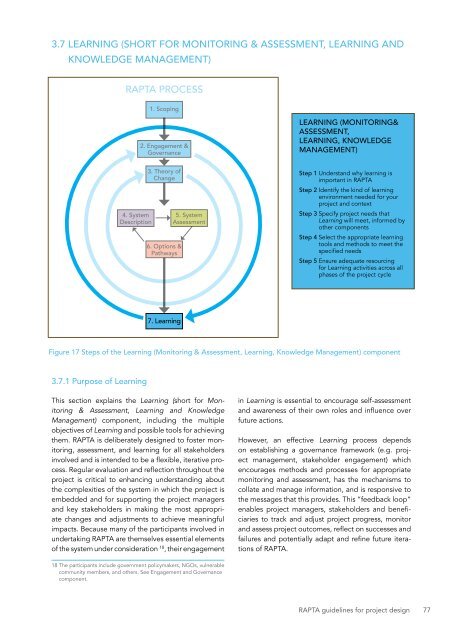DESIGNING PROJECTS IN A RAPIDLY CHANGING WORLD
srun3013fp1
srun3013fp1
You also want an ePaper? Increase the reach of your titles
YUMPU automatically turns print PDFs into web optimized ePapers that Google loves.
3.7 LEARN<strong>IN</strong>G (SHORT FOR MONITOR<strong>IN</strong>G & ASSESSMENT, LEARN<strong>IN</strong>G AND<br />
KNOWLEDGE MANAGEMENT)<br />
RAPTA PROCESS<br />
1. Scoping<br />
2. Engagement &<br />
Governance<br />
LEARN<strong>IN</strong>G (MONITOR<strong>IN</strong>G&<br />
ASSESSMENT,<br />
LEARN<strong>IN</strong>G, KNOWLEDGE<br />
MANAGEMENT)<br />
4. System<br />
Description<br />
3. Theory of<br />
Change<br />
6. Options &<br />
Pathways<br />
5. System<br />
Assessment<br />
Step 1 Understand why learning is<br />
important in RAPTA<br />
Step 2 Identify the kind of learning<br />
environment needed for your<br />
project and context<br />
Step 3 Specify project needs that<br />
Learning will meet, informed by<br />
other components<br />
Step 4 Select the appropriate learning<br />
tools and methods to meet the<br />
specified needs<br />
Step 5 Ensure adequate resourcing<br />
for Learning activities across all<br />
phases of the project cycle<br />
7. Learning<br />
Figure 17 Steps of the Learning (Monitoring & Assessment, Learning, Knowledge Management) component<br />
3.7.1 Purpose of Learning<br />
This section explains the Learning (short for Monitoring<br />
& Assessment, Learning and Knowledge<br />
Management) component, including the multiple<br />
objectives of Learning and possible tools for achieving<br />
them. RAPTA is deliberately designed to foster monitoring,<br />
assessment, and learning for all stakeholders<br />
involved and is intended to be a flexible, iterative process.<br />
Regular evaluation and reflection throughout the<br />
project is critical to enhancing understanding about<br />
the complexities of the system in which the project is<br />
embedded and for supporting the project managers<br />
and key stakeholders in making the most appropriate<br />
changes and adjustments to achieve meaningful<br />
impacts. Because many of the participants involved in<br />
undertaking RAPTA are themselves essential elements<br />
of the system under consideration 18 , their engagement<br />
in Learning is essential to encourage self-assessment<br />
and awareness of their own roles and influence over<br />
future actions.<br />
However, an effective Learning process depends<br />
on establishing a governance framework (e.g. project<br />
management, stakeholder engagement) which<br />
encourages methods and processes for appropriate<br />
monitoring and assessment, has the mechanisms to<br />
collate and manage information, and is responsive to<br />
the messages that this provides. This “feedback loop”<br />
enables project managers, stakeholders and beneficiaries<br />
to track and adjust project progress, monitor<br />
and assess project outcomes, reflect on successes and<br />
failures and potentially adapt and refine future iterations<br />
of RAPTA.<br />
18 The participants include government policymakers, NGOs, vulnerable<br />
community members, and others. See Engagement and Governance<br />
component.<br />
RAPTA guidelines for project design 77


